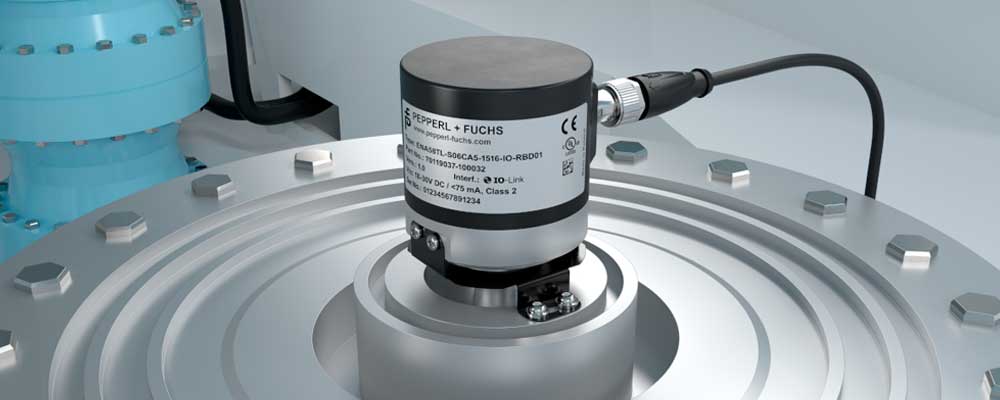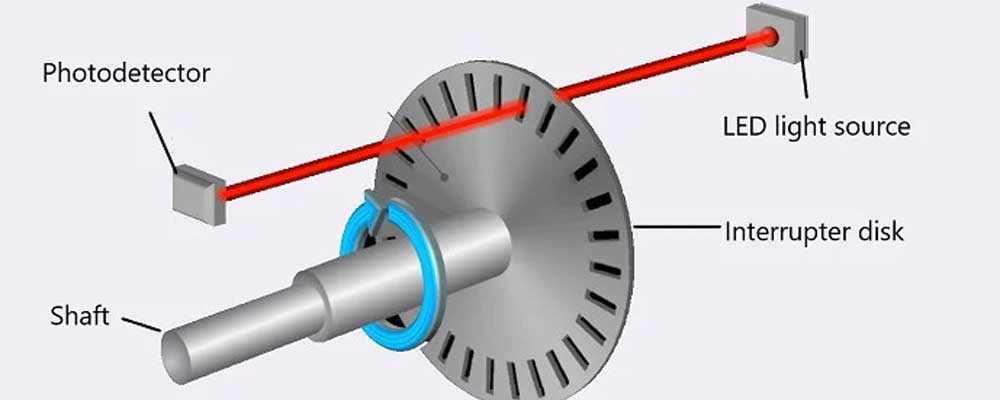How Do Rotary Encoders Work?
A rotary encoder is a sensor that detects the position, velocity, and direction of a rotating shaft or object. It’s a critical tool in translating rotational motion into a readable format for machines and control systems.
The key difference between rotary encoders and linear encoders lies in their application. Rotary encoders are used for rotational motion, making them essential in tasks like monitoring the speed of a motor or the position of a rotating arm. Linear encoders, in contrast, are used for straight-line movements, such as measuring the distance a CNC machine table moves.
Choosing the right type of encoder – rotary for rotational movements and linear for linear movements – is essential for accurate and efficient system performance.
Types of Rotary Encoders:
In the world of rotary encoders, there are two primary types of Rotary encoders that industrial engineers often work with: Absolute Rotary Encoders and Incremental Rotary Encoders. Understanding the differences between these two is key to selecting the right one for your application.
Absolute Rotary Encoders:
Absolute encoders are like the GPS of the encoder world. Each position of the encoder corresponds to a unique code or output. This means they can provide the exact position of the rotating shaft at any given time, without needing to reference a starting point. They’re invaluable in applications where knowing the precise position immediately after power-up is crucial, such as in robotics or high-precision manufacturing.
Incremental Rotary Encoders:
Think of these as step counters. They provide information about the movement of the shaft in terms of increments or steps from a certain reference point. However, unlike absolute encoders, they don’t tell you the exact position. They’re ideal for applications where you need to track movement or speed rather than a specific position, like in motor speed monitoring. A prime example of this type is the Omron 1000ppr encoder, known for its high resolution, making it suitable for applications that require precise speed and movement tracking.
Choosing between these two types depends on your specific needs. If absolute position is critical, go for absolute encoders. If you’re more concerned with movement or speed, incremental encoders are your best bet.
Working Principle of Rotary Encoders:
Let’s break down the working principle of rotary encoders in a nutshell. These devices are all about translating the physical movement of a shaft into an electrical signal, which can then be used for various control and measurement purposes in industrial applications.
At the core of a rotary encoder, you’ll typically find a disc attached to the rotating shaft. This disc is marked with a series of lines or slots. Alongside the disc, there are key components like a light source and a light detector. As the disc rotates, the markings on it either block or allow light to pass through to the detector. This interaction creates a pattern of light and dark, which is then converted into an electrical signal.
For absolute encoders, each position of the disc corresponds to a unique signal pattern, allowing the device to determine the exact position of the shaft. In contrast, incremental encoders generate a series of pulses as the disc rotates, providing information about the movement or speed of the shaft, rather than its exact position.
In essence, rotary encoders are sophisticated translators. They take the mechanical language of rotating shafts and convert it into the electrical language of signals, enabling precise control and measurement in a wide range of industrial applications.
Applications of Rotary Encoders:
Rotary encoders have a broad spectrum of applications, each leveraging their ability to provide precise control and feedback.
Let’s briefly touch on their key uses in various fields:
Industrial Automation: In the realm of industrial automation, rotary encoders are indispensable. They are often employed in controlling the movement and positioning of machinery. For instance, in a manufacturing assembly line, encoders ensure that robotic arms and conveyor belts operate with pinpoint accuracy, contributing to efficiency and precision in production processes.
Robotics: In robotics, rotary encoders play a critical role in controlling the movement of robotic components. Whether it’s in industrial robots performing complex assembly tasks or in more advanced robotic systems used in research and exploration, encoders provide the necessary feedback to ensure precise and controlled motion.
Rotary encoders are key components in a wide range of applications, from heavy industrial machinery to the delicate controls of consumer electronics. Their ability to accurately translate physical motion into electronic signals makes them a cornerstone in modern engineering and automation.
Encoder Configurations and Output Types:
Rotary encoders come in various configurations and output types, each suited to specific applications. In discussing rotary encoders, it’s important to consider not just their design variations and signal types, but also the nature of their outputs, such as PNP, NPN, and Push-Pull, Line Drive.
Let’s explore these aspects:
Design Variations:
The design of a rotary encoder can vary based on its intended application. For instance, heavy-duty encoders are built to withstand harsh industrial environments, featuring robust construction to resist factors like vibration, dust, and moisture. On the other hand, encoders designed for precision instruments focus more on sensitivity and accuracy. The choice of design directly impacts the encoder’s performance and suitability for different environments.
Output Signals:
The type of output signal an encoder generates is crucial in determining how it communicates with other system components.
There are primarily three types of signals:
Binary Output: This is the most straightforward form of output, where the encoder generates a simple on/off signal. It’s commonly used in applications where basic position or motion detection is required.
Gray Code Output: Gray code is a binary numeral system where two successive values differ in only one bit. This output is particularly useful in reducing errors in signal interpretation, especially in high-speed applications.
Analog Output: Analog encoders provide a continuous signal, which can represent more complex positional data. This type is often used in applications requiring detailed and nuanced control, such as in robotics or precision machining.
Understanding these configurations and output types is essential for industrial engineers. It helps in selecting the right encoder for a specific application, ensuring optimal performance and integration with other system components.
Output Configurations:
PNP Output: ‘Positive-Negative-Positive’ output refers to the type of transistor used. PNP outputs are common in industrial applications where the encoder needs to interface with higher voltage systems.
NPN Output: ‘Negative-Positive-Negative’ outputs are another transistor type, often used in lower voltage systems. They are typically more common in compact or battery-operated devices.
Push-Pull Output: This type offers both PNP and NPN outputs, making them versatile for various applications. Push-pull outputs can interface with a wide range of devices, making them suitable for diverse industrial environments.
Line Drive Output: This type is designed to offer strong signal integrity over longer distances. Line Drive outputs can transmit signals with less degradation and interference, making them ideal for environments where the encoder is located far from the control system or in areas with high electrical noise.
Challenges in Using Rotary Encoders:
When integrating rotary encoders into industrial systems, engineers face several challenges that are crucial to address for optimal performance:
Selecting the Appropriate Type:
The first hurdle is choosing between absolute and incremental encoders. Absolute encoders are ideal for applications requiring precise, absolute position data, like robotic arms in assembly lines. Incremental encoders, offering relative position data, are better suited for tasks like speed monitoring in conveyor systems. The choice hinges on the specific needs of the application – precision, cost, and environmental factors.
Installation Considerations:
Proper installation is key. For instance, an encoder must be correctly aligned with the axis of rotation. Misalignment can lead to inaccurate readings or even premature wear and tear. It’s like fitting a gear – it needs to mesh seamlessly with the system.
Alignment Challenges:
Precise alignment is critical, especially in high-precision environments. Even a slight deviation can cause significant errors in the encoder’s readings.
Environmental Factors:
Encoders must be chosen and installed considering the operating environment. In harsh conditions, like extreme temperatures or high levels of dust and moisture, robust encoders with appropriate protective measures are necessary. It’s similar to selecting the right attire for a specific climate – the better the fit, the more comfortable and effective you are.
Electrical Compatibility:
Ensuring the encoder’s electrical output is compatible with the rest of the system is another challenge. This includes matching voltage levels and output types (like PNP, NPN, or Line Drive) to the system’s requirements. It’s like ensuring all components in an electrical circuit are compatible for smooth operation.
For industrial engineers, navigating these challenges is part of ensuring that the rotary encoders not only fit into the system but also perform optimally under the specific conditions of their application.
Conclusion:
Rotary encoders are fundamental in industrial engineering for translating rotational movements into electronic data. We have two main types: Absolute encoders, which are like precise GPS systems providing exact location data, and Incremental encoders, akin to step counters, ideal for tracking speed and movement.
The choice between these types depends on your specific needs. Do you require precise positional data, or is tracking movement more important? Additionally, understanding their various configurations and outputs, like PNP, NPN, or Line Drive, is crucial for ensuring they fit seamlessly into your system.
Remember, selecting the right encoder and installing it correctly is key. It’s like choosing the right tool for a job – the better the fit, the more effective the outcome. For us in industrial engineering, mastering the use of rotary encoders is not just about using a component; it’s about enhancing precision and efficiency in our automated systems.




